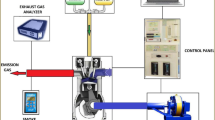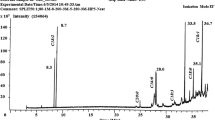Abstract
The present work studies and identifies the different variables that affect the output parameters involved in a single cylinder direct injection compression ignition (CI) engine using jatropha biodiesel. Response surface methodology based on Central composite design (CCD) is used to design the experiments. Mathematical models are developed for combustion parameters (Brake specific fuel consumption (BSFC) and peak cylinder pressure (Pmax)), performance parameter brake thermal efficiency (BTE) and emission parameters (CO, NO x , unburnt HC and smoke) using regression techniques. These regression equations are further utilized for simultaneous optimization of combustion (BSFC, Pmax), performance (BTE) and emission (CO, NO x , HC, smoke) parameters. As the objective is to maximize BTE and minimize BSFC, Pmax, CO, NO x , HC, smoke, a multiobjective optimization problem is formulated. Nondominated sorting genetic algorithm-II is used in predicting the Pareto optimal sets of solution. Experiments are performed at suitable optimal solutions for predicting the combustion, performance and emission parameters to check the adequacy of the proposed model. The Pareto optimal sets of solution can be used as guidelines for the end users to select optimal combination of engine output and emission parameters depending upon their own requirements.
Similar content being viewed by others
References
Thiruvengadaravi K V, Nandagopal J, Baskaralingam P, Bala V S S, Sivanesan S. Acid-catalyzed esterification of karanja (Pongamia Pinnata) oil with high free fatty acid for biodiesel production. Fuel, 2012, 98: 1–4
Bala V S S, Thiruvengadaravi K V, Sentil Kumar P S, Premkumar M P, Kumar V V, Sankar S S, Hari M. Removal of free fatty acid in Pongamia Pinnata (Karanja) oil using divinylbenzene-styrene copolymer resins for biodiesel production. Biomass and Bioenergy, 2012, 37: 335–341
Dhingra S, Dubey K K, Bhushan G.Enhancement in Jatropha based biodiesel yield by process optimization using design of experiment approach. International Journal of Susainable Energy, 2013, (Published online).
Dhingra S, Bhushan G, Dubey K K. Development of combined approach for improvement and optimization of Karanja (Pongamia pinnata) biodiesel using response surface methodology and genetic algorithm. Frontiers in Energy, 2013
Bojan S G, Chelladurai S, Durairaj S K. Chelledurai, Durairaj S K. Response surface methodology for optimization of biodiesel production from high FFA Jatropha curcas oil. International Journal of Green Energy, 2011, 8(6): 607–617
Nabi N, Rehman M, Akhter S. Biodiesel from cotton seed oil and its effect on engine performance and exhaust emissions. Applied Thermal Engineering, 2008, 29(11–12): 2265–2270
Gumus M A. Comprehensive experimental investigation of combustion and heat release characteristics of a biodiesel (hazelnut kernel oil methyl ester) fuelled direct injection compression ignition engine. Fuel, 2010, 89(10): 2802–2814
Balajiganesh N, Chandra Mohan Reddy B. Optimization of C.I Engine parameters using Artificial Neural. International Journal of Mechanical and Industrial Engineering, 2011, 1(2), ISSN No. 2231–6477
Kiani Deh Kiani M, Ghobadian B, Tavakoli T, Nikbakht A M, Najafi G. Application of artificial neural networks for the prediction of performance and exhaust emissions in SI engine using ethanolgasoline blends. Energy, 2009, 4: 1–5
Karuppasamy K, Syed Abu Thaheer A, Ahmed Basha C, Mannivannan A. The effect of biodiesel blends on single cylinder DI diesel engine and optimization using response surface methodology. European Journal of Scientific Research, 2012, 84(3): 365–376
De Lucas A, Duran A, Carmona M, Lapuerta M. Modelling diesel particulate emissions with neural networks. Fuel, 2001, 80(4): 539–548
Krijnsen H, Van Kooten W, Calis H, Verbeek R, Venden Bleek C. Evaluation of an artificial neural network for NO prediction from a transient diesel engine as a base for ANN would be well suited to inventory prediction from transient diesel engine as base for NOx control. Canadian Journal of Chemical Engineering, 2000, 78(2): 408–417
Mudgal A, Gopalkrishnan K, Hallmark S. Prediction of emissions from biodiesel fuelled transit buses using artificial neural networks. International Journal of Traffic and Transport Engineering, 2011, 1(2): 115–131
Muralidharan K, Vasudevan D, Sheeba K N. Performance emission and combustion characteristics of biodiesel fuelled variable compression ratio engine. Energy, 2011, 36(8): 5385–5393
Ganapathy T, Gakhar R P, Murugesan K. Optimization of performance parameters of diesel engine with jatropha biodiesel using response surface methodology. International Journal of Sustainable Energy, 2011, 30(sup1 S1): S76–S90
Kuti O A, Xiangang WG, Nishida K, Huang Z H. Characteristics of ignition and combustion of biodiesel fuel spray injected by a common-rail injection system for a direct-injection diesel engine. Proceedings of the Institution of Mechanical Engineers. Part D, Journal of Automobile Engineering, 2010, 224(12): 1581–1596
Ramdhas A S, Muraleedharan C, Jayaraj S. Performance and emission evaluation of a diesel engine fuelled with methyl esters of rubber seed oil. Renewable Energy, 2005, 20: 1–12
Lin G H, Kuo C P. Effects of the injection timing on the engine performance and the exhaust emissions of a diesel engine fuelled by tyre-pyrolysis oil-diesel blends. Proceedings of the Institution of Mechanical Engineers. Part D, Journal of Automobile Engineering, 2013, 227(8): 1153–1161
Jindal S, Salvi B L. Sustainability aspects and optimization of linseed biodiesel blends for compression gnition engine. Journal of Renewable and Sustainable Energy, 2012, 4(4): 043111
Muralidharan K, Vasudevan D, Sheeba K N. Performance emission and combustion characteristics of biodiesel fuelled variable compression ratio engine. Energy, 2011, 36(8): 5385–5393
Deb K, Agarwal R B. Simulated Binary Crossover for Continuous Search Space. Complex Systems, 1995, 9: 115–148
Raghuwanshi M M, Kakde O G. Survey on multi-objective evolutionary and real coded genetic algorithms. Proceedings of the 8th Asia Pacīc Symposium on Intelligent and Evolutionary Systems, 2004, 150–161
Beyer H G, Deb K. On Self-Adaptive Features in Real-Parameter Evolutionary Algorithm. IEEE Transactions on Evolutionary Computation, 2001, 5(3): 250–270
Srinivas N, Deb K. Multi-objective Optimization Using Nondominated Sorting in Genetic Algorithms. Evolutionary Computation, 1994, 2(3): 221–248
Deb K, Pratap A, Agarwal S, Meyarivan T. A Fast Elitist Multiobjective Genetic Algorithm: NSGA-II. IEEE Transactions on Evolutionary Computation, 2002, 6(2): 182–197
Garg M P, Jain A, Bhushan G. Modelling and multi-objective optimization of process parameters of wire electrical discharge machining using non-dominated sorting genetic algorithm-II. Proceedings of the Institution of Mechanical Engineers. Part B, Journal of Engineering Manufacture
Author information
Authors and Affiliations
Corresponding author
Rights and permissions
About this article
Cite this article
Dhingra, S., Bhushan, G. & Dubey, K.K. Multi-objective optimization of combustion, performance and emission parameters in a jatropha biodiesel engine using Non-dominated sorting genetic algorithm-II. Front. Mech. Eng. 9, 81–94 (2014). https://doi.org/10.1007/s11465-014-0287-9
Received:
Accepted:
Published:
Issue Date:
DOI: https://doi.org/10.1007/s11465-014-0287-9




